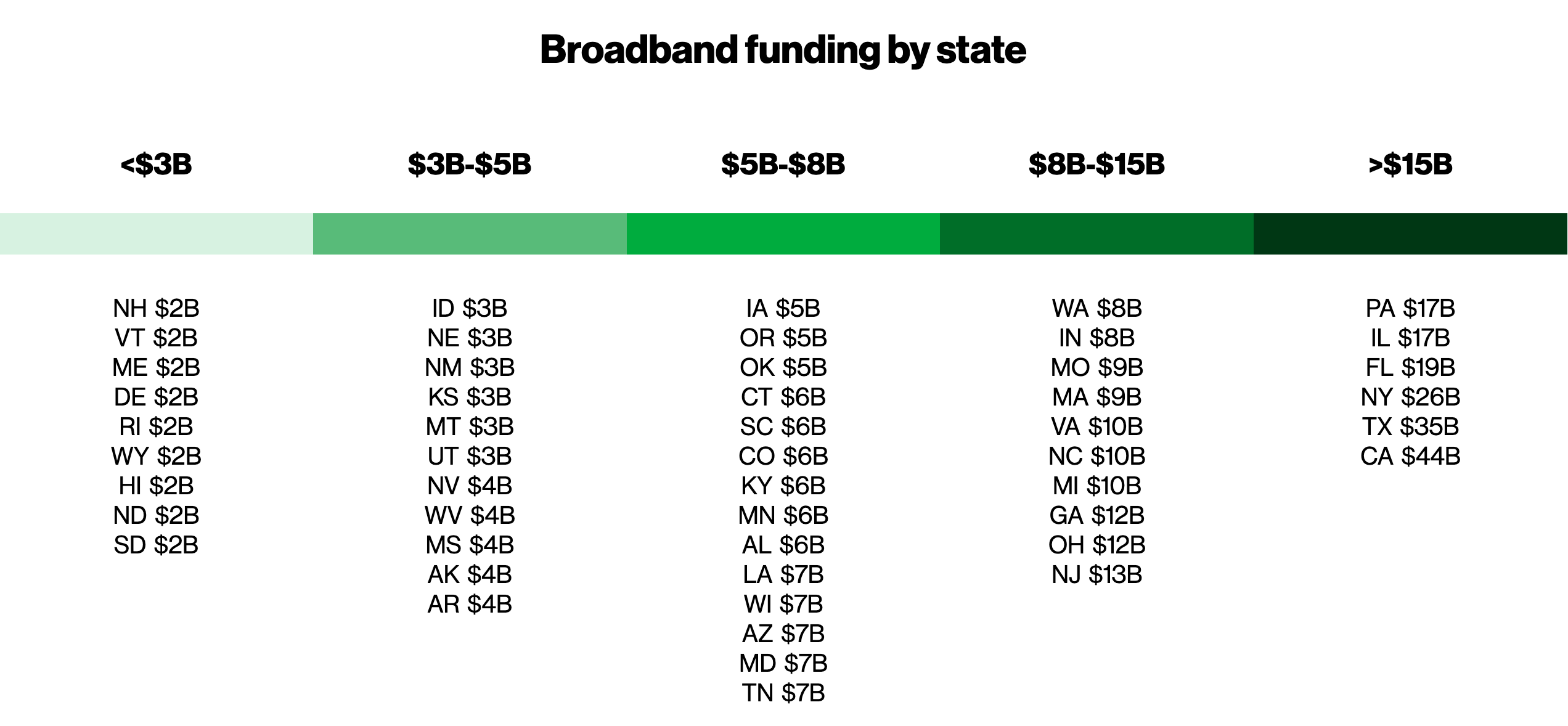Overview
Signed into law in 2021, the IIJA authorizes unprecedented federal funding opportunities for government entities, tribal nations and nonprofits. It is designed to help strengthen the nation’s physical and digital infrastructures.
Available funds
The law authorizes $1.2 trillion for transportation and infrastructure spending at the state and local levels. $550 billion of that figure must be spent before 2026.
Benefits
Connectivity has become an essential form of infrastructure. That’s why the IIJA is helping to bridge the digital divide via a $65 billion investment in broadband development—the largest in history.
Access
The Broadband Equity, Access, and Deployment (BEAD) Program is the centerpiece of the IIJA broadband initiative.
Coverage
Broadband allocations will be primarily disbursed by select federal organizations and individual states.
Funding opportunities
Explore IIJA-eligible infrastructure projects types, across funding themes, and visit the Government Finance Office Association to explore even more.

Airport terminals
Projects that replace aging terminals and increase terminal energy efficiency
Airport infrastructure
Projects that increase safety and expand capacity
Air traffic facilities
Projects that replace facilities and equipment and improve safety and security
More information about funding opportunities is available through the Federal Aviation Administration.

Energy
Broadly, this portion of IIJA funding has been earmarked for upgrading outdated power grids. Included in those modernization efforts is a focus on finding new ways to increase energy efficiency and decrease energy consumption, which includes measures for:
- Clean energy initiatives
- Community resiliency programs
- Alternative fuel vehicles
- Supply chains
More information about funding opportunities is available through the Department of Energy.

Energy Improvement in Rural and Remote Areas
(Available until expended)
Some of the funds allocated for energy initiatives have been used to establish competitive grants. These programs provide financial assistance for environmental protection and improve resilience, reliability, safety and energy availability in remote areas of the United States.
More information about these funding opportunities is available through the Department of Energy.

Renew America’s Schools Program
(Available until expended)
Competitive grants have been established to make specific improvements at public schools. These use cases include:
- Energy efficiency (e.g., smart lighting)
- Ventilation
- Renewable energy
- Alternative vehicles
- Alternative fuel vehicle infrastructure improvements
More information about these grant opportunities is available through the Department of Energy.

Utilities
Powered by cellular-based advanced metering infrastructure (AMI) solutions and analytics, next-generation smart grid solutions that provide reliable, robust, secure and future-proof technologies. IIJA funding initiatives support clean energy and community resiliency programs that offer demonstrable returns on investment and benefits to customers and communities.
The Internet of Things (IoT)
IIJA also supports intelligent systems, such as:
- Electric Vehicle (EV) charging
- Smart lighting
- Conditioned-based management and asset tracking

Transportation
The transportation funding granted by the IIJA is intended to support transformational projects that make the nation’s transportation systems safer and more resilient. A wide variety of use cases is eligible for a portion of these funds, including but not limited to:
- Roads and bridges
- Passenger and freight rail
- Public transit
- Airports
- Ports and waterways
- Safety and research
- Electric vehicle charging
More information about funding opportunities is available through the Department of Transportation.
Additional resources
Broadband and public infrastructure
Get an overview of the four main funding opportunities the IIJA offers to broadband service providers.
Cybersecurity predictions for 2024
Public Sector continues to be a leading target for hackers. See how government entities can prepare in the new year.
Cybersecurity and IIJA
Learn how the federal government can help secure critical data with funding from the IIJA.
Cybersecurity and IIJA fact sheet
This Infrastructure Investment and Jobs Act (IIJA) fact sheet illustrates what cybersecurity programs and jobs the IIJA is funding and programs that support it.
Cybersecurity and IIJA infographic
Government agencies are confronted by cybersecurity threats that are growing in frequency and sophistication constantly. Learn how Verizon's cybersecurity solutions can help your organization.
Fact sheet Smarter infrastructure with IIJA
Learn about the variety of funding sources the IIJA relies on, such as grants, competitive programs and merit-based applications.
Fact sheet 2023 infrastructure trailblazers
Read how community leaders are building transformative tech projects across the country.
Video Congressional renewable energy and energy efficiency policy forum
Watch panelists discuss how the bipartisan IIJA is promoting energy system modernization and renewable energy resources.
Website Clean energy infrastructure opportunities
Learn about the infrastructure funding programs available through the Department of Energy (DOE).
FAQs
They’re actually the same bill! IIJA also has several other names and is referred to in many ways — the Invest in America Act, the infrastructure bill — or even by allocation areas and funding sources, like
- Broadband Equity, Access and Deployment (BEAD), Affordable Connectivity, digital equity and Internet for All in the broadband category
- Strengthening Mobility and Revolutionizing Transportation (SMART) IoT or National Electric Vehicle Infrastructure (NEVI) from the Department of Transportation
- Grid innovation or smart grid grants from the Department of Energy
Funds are being delivered to state, local, tribal governments and some nationwide entities through formulas and competitive solicitations — it varies with the federal department overseeing each program. Each participating department has an IIJA website outlining requirements and Notice of Funding Opportunity (NOFO).
Because there are multiple federal agencies, programs, and types of funding the timelines vary. The relevant agency (i.e. Federal Communications Commission, Department of Commerce, Department of Transportation, National Telecommunications and Information Administration (NTIA) or Department of Energy) will provide application information and including related deadlines on their website.
Federal spending on infrastructure is usually part of the federal budget. Infrastructure investment peaked in the 1970s, at about 2 percent of the gross domestic product (GDP). But in terms of dedicated investments in the vein of IIJA, you’d have to go all the way back to the New Deal recovery effort of the 1930s. Yet even that famous initiative, which created well-known structures like the Hoover Dam, the Lincoln Tunnel and the Tennessee Valley Authority, didn’t match the infrastructure investment of IIJA.
Technology is a key component of the infrastructure bill, and Verizon is a leading partner for government and public sector. As Verizon offers best-in-class networking, cybersecurity and IoT solutions, we are excited about the historic opportunity offered by IIJA and inspired by the prospect of transforming our country’s virtual infrastructure.
Learn more:
Verizon Internet of Things (IoT) Solutions
1 Map data as of February 2022. https://www.whitehouse.gov/invest/
2 Map data as of February 2022. https://www.whitehouse.gov/build/resources/state-fact-sheets/
3 Map data as of February 2022. https://broadbandmap.fcc.gov/home
4 Report results are based on self-reported information and are for assessment purposes only. Your actual data systems and information configurations and needs may differ from these results and report insights. You should not rely on this report in lieu of a professional assessment of your data.




